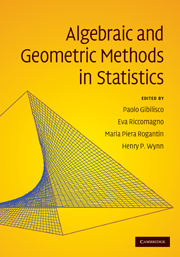Book contents
- Frontmatter
- Contents
- List of contributors
- Preface
- Frequently used notations and symbols
- 1 Algebraic and geometric methods in statistics
- Part I Contingency tables
- Part II Designed experiments
- Part III Information geometry
- Part IV Information geometry and algebraic statistics
- Part V On-line supplements
- 22 Maximum likelihood estimation in latent class models for contingency table data
- 23 The generalised shuttle algorithm
- 24 Indicator function and sudoku designs
- 25 Replicated measurements and algebraic statistics
25 - Replicated measurements and algebraic statistics
from Part V - On-line supplements
Published online by Cambridge University Press: 27 May 2010
- Frontmatter
- Contents
- List of contributors
- Preface
- Frequently used notations and symbols
- 1 Algebraic and geometric methods in statistics
- Part I Contingency tables
- Part II Designed experiments
- Part III Information geometry
- Part IV Information geometry and algebraic statistics
- Part V On-line supplements
- 22 Maximum likelihood estimation in latent class models for contingency table data
- 23 The generalised shuttle algorithm
- 24 Indicator function and sudoku designs
- 25 Replicated measurements and algebraic statistics
Summary
Proofs
Theorem 11.3 Consider n distinct points
Proof At first, we prove that the ideal J ⊂ S</> is homogeneous, that is to say, if
A remarkable property of homogeneous ideals in polynomial rings is that they can be generated by homogeneous polynomials. Secondly, we prove that
To simplify notation, set
Now, we prove that there exists a monomial ideal
is flat, with fibers of dimension 0 and degree r + s.
If one or more points among the Qj 's belong to some lines among l1, …,lr then for some values we obtain some double points, but the family is still flat as a straightforward computation shows.
If one point among the Qj 's or one among the Pi 's is the origin, then again the family is flat for the same reasons as before.
Theorem 11.8 In the hypotheses and notation of Theorem 11.7, for every i = 1,…,r it holds
Proof The hypotheses guarantee that the polynomial ci is equal to
Proof The existence and uniqueness of F is a consequence of the isomorphism
By its properties, we have that F – Fi ε Ji, for i = 1,…, m. Then, we impose that NF(F1 + H – Fi) = 0 in R/Ji. By rewriting the polynomial F1 + H – Fi modulo Gi we get a polynomial with coefficients that are linear polynomials in the variables ar1 + 1,…, ar.
- Type
- Chapter
- Information
- Algebraic and Geometric Methods in Statistics , pp. 424 - 426Publisher: Cambridge University PressPrint publication year: 2009



